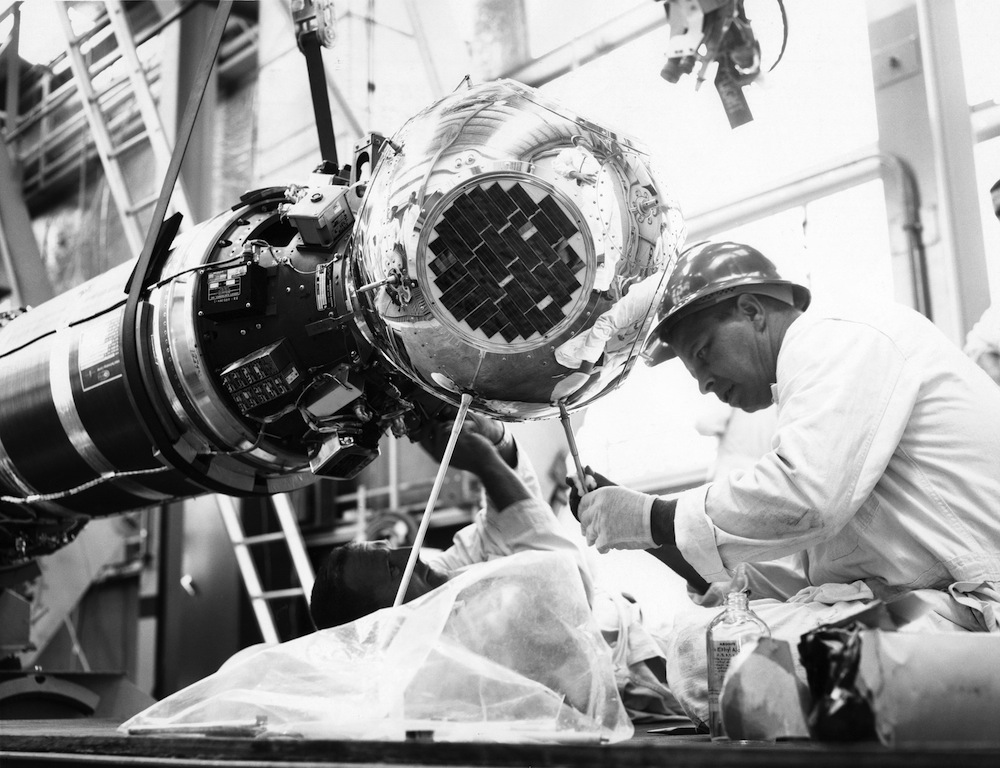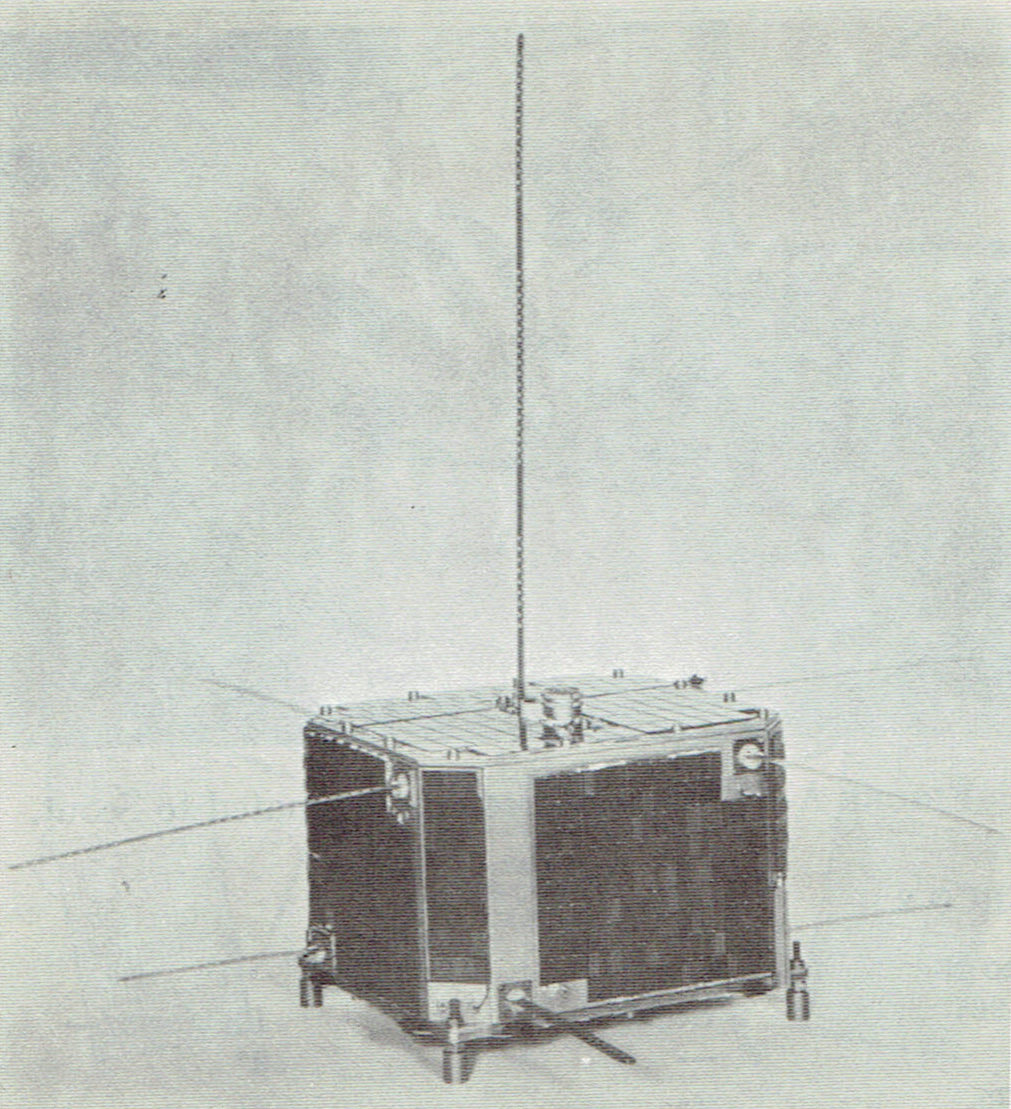SECOR on:
[Wikipedia]
[Google]
[Amazon]
SECOR (Sequential Collation of Ranges) was a series of small

 These later satellites were made in the shape of a rectangular prism, measuring . They were almost fully covered in solar cells, and the antennas were made of flexible steel tape. They were much more compact, and thus worked better as secondary payloads. They were designed to avoid removing covers and panels during satellite pre-launch checks. Their antennas were perforated, to diminish antenna shadow over the solar panels.
These later satellites were made in the shape of a rectangular prism, measuring . They were almost fully covered in solar cells, and the antennas were made of flexible steel tape. They were much more compact, and thus worked better as secondary payloads. They were designed to avoid removing covers and panels during satellite pre-launch checks. Their antennas were perforated, to diminish antenna shadow over the solar panels.
United States Armed Forces
The United States Armed Forces are the military forces of the United States. The armed forces consists of six service branches: the Army, Marine Corps, Navy, Air Force, Space Force, and Coast Guard. The president of the United States is ...
satellites launched in the 1960s for geodesy measurements that precisely determined the locations of points on the Earth's surface, particularly of isolated islands in the Pacific Ocean
The Pacific Ocean is the largest and deepest of Earth's five oceanic divisions. It extends from the Arctic Ocean in the north to the Southern Ocean (or, depending on definition, to Antarctica) in the south, and is bounded by the contin ...
. This data allowed for improved global mapping and precise positioning of ground stations for other satellites.
Any SECOR satellite could be linked to four mobile ground stations: three were placed in accurately determined known locations, and a fourth one was placed in an unknown location. By measuring a satellite's distance from the three known stations, its position in space was determined. Then, the distance between the unknown ground station and the previously determined satellite's position was used to compute the unknown ground station's coordinates. This process was repeated many times, to enhance the accuracy of the measurement. Once the unknown station's position was accurately determined, it became a known station. Then one of the four stations was moved to a new unknown point, and the process began again.
SECOR was a predecessor to navigational satellite systems such as Timation
The Timation satellites were conceived, developed, and launched by the United States Naval Research Laboratory in Washington, D.C. beginning in 1964. The concept of Timation was to broadcast an accurate time reference for use as a ranging signal ...
and Navstar-GPS (Global Positioning System).
Satellites
Fifteen dedicated SECOR satellites were made, and eight SECOR transponders flew as a subsystem of other satellites. Two versions of SECOR satellites were built, Type I and Type II. They had several differences, but they also shared many features. Therefore, a detailed description is provided for Type I, and a differences-only summary for Type II.Type I

Description
The Type 1 SECOR satellites were spherical, in diameter, in construction similar toVanguard III
Vanguard 3 (Harvard designation: 1959 Eta 1) is a scientific satellite that was launched into Earth orbit by the Vanguard SLV-7 on 18 September 1959, the third successful Vanguard launch out of eleven attempts. Vanguard rocket: Vanguard Satell ...
and the early SOLRAD
SOLRAD (short for "SOLar RADiation," sometimes presented as "SOLRAD") was an American series of satellites sponsored by the US Navy in a program to continuously monitor the Sun. SOLRAD was the Naval Research Laboratory's first post-Vanguard satell ...
/Galactic Radiation and Background
Galactic Radiation and Background (GRAB) was the first successful United States orbital surveillance program, comprising a series of five Naval Research Laboratory electronic surveillance and solar astronomy satellites, launched from 1960 to ...
(GRAB) spacecraft. The satellites massed in average, with most of it being batteries and voltage regulators. Their surface was made of polished aluminium covered with a thin layer of silicon monoxide
Silicon monoxide is the chemical compound with the formula SiO where silicon is present in the oxidation state +2. In the vapour phase, it is a diatomic molecule.
It has been detected in stellar objects and has been described as the most common o ...
to help with thermal regulation. There were nine collapsible antennas, eight around the equator for distance measurement and one atop the sphere for telemetry and command. A hollow cone connected the upper stage of the launch vehicle to the base of the satellite. Expected lifespan was one year.
Electrical power
Six sets of 160solar cell
A solar cell, or photovoltaic cell, is an electronic device that converts the energy of light directly into electricity by the photovoltaic effect, which is a physical and chemical phenomenon.
s were mounted on aluminium plates around the surface, providing 17 volts. Within the sphere, a vertically aligned cylinder housed the batteries and voltage regulators. A stable voltage was essential for accurate transponder operation, and, in addition to the voltage regulators, each battery cell in the battery was matched to within 0.03 volts in their discharge curves.
Transponder
Thetransponder
In telecommunications, a transponder is a device that, upon receiving a signal, emits a different signal in response. The term is a blend of ''transmitter'' and ''responder''.
In air navigation or radio frequency identification, a flight trans ...
was placed on a framework within the remaining space.
Telemetry
Each satellite was equipped to transmit data such as battery charge, voltages, temperature of equipment inside the satellite, etc. Later satellites had more telemetry channels.Passive attitude control
On the inner side of the skin, a magnetic rod was placed. It aligned itself withEarth's magnetic field
Earth's magnetic field, also known as the geomagnetic field, is the magnetic field that extends from Earth's interior out into space, where it interacts with the solar wind, a stream of charged particles emanating from the Sun. The magnetic ...
, thus keeping the satellite in a constant orientation. Also inside the skin, many despin coils were placed. These devices were used to stop undesired rotation induced by launch vehicle
A launch vehicle or carrier rocket is a rocket designed to carry a payload ( spacecraft or satellites) from the Earth's surface to outer space. Most launch vehicles operate from a launch pads, supported by a launch control center and ...
separation, and by passing near the magnetic poles of Earth. The despin coils were simply large wire coils that were electrically shorted. Rotational movement within Earth's magnetic field induced current on the coils. The current in the coils generated a magnetic field of its own that opposed Earth's, thus slowing the satellite's rotation. As the coils were shorted, the electric current was converted to heat and dissipated to space. The initial braking took several days because of the weak magnetic field at the typical SECOR orbital altitudes.
Type II
 These later satellites were made in the shape of a rectangular prism, measuring . They were almost fully covered in solar cells, and the antennas were made of flexible steel tape. They were much more compact, and thus worked better as secondary payloads. They were designed to avoid removing covers and panels during satellite pre-launch checks. Their antennas were perforated, to diminish antenna shadow over the solar panels.
These later satellites were made in the shape of a rectangular prism, measuring . They were almost fully covered in solar cells, and the antennas were made of flexible steel tape. They were much more compact, and thus worked better as secondary payloads. They were designed to avoid removing covers and panels during satellite pre-launch checks. Their antennas were perforated, to diminish antenna shadow over the solar panels.
Non-dedicated
SECOR transponders were also attached to a number of satellites. While the specific implementation was done on a case-by-case basis, the general idea was to place a transponder either outside/inside of a host satellite, sharing power, antennas, and telemetry with other experiments.Ground stations
The ground stations were transportable. They consisted of three shelters, one for radio equipment, one for data handling, and one for storage. Generators and air conditioning for the electronic equipment were included. Lighter weight,solid-state electronics
Solid-state electronics means semiconductor electronics: electronic equipment using semiconductor devices such as transistors, diodes and integrated circuits (ICs). The term is also used as an adjective for devices in which semiconductor electr ...
equipment was eventually developed to replace the initial units.
Radio equipment
The equipment was designed for all-weather operation. * Send Transponder on/off command * Receive Satellite Battery Voltage * Receive Satellite temperatures (shell, battery and amplifier)Data handling
The data was recorded on magnetic tape and processed by a computer.Storage
* Fuel and other consumablesSystem operation
* Determine the distance between the satellite and the stations several times. * Compute the position of the satellite relative to the three known stations by trilateration. * Compute the possible positions of the unknown ground station that could yield the measured distance. * Repeat the cycle, narrowing down the set of possible positions with each satellite pass until the accuracy is deemed acceptable. First, the distances between each station and a satellite were obtained and recorded. The distances between the known positions and this satellite were used to determine the satellite's location in space, and then, the previously measured distance from the fourth station and the calculated satellite position were used to calculate the coordinates of the fourth station with respect to the three known stations. The accuracy of the position calculations was enhanced by the great amount of data obtained in each satellite pass. At about 70 measurements per second, and considering the time the satellite was visible from the ground station, a typical satellite pass yielded approximately 48,000 measurements. Because depending on the exact angle between the satellite and a ground station, the precision could have variation, data was collected during several passes. This allowed data from the best passes to be selected, while still conserving a great amount of redundancy. Once enough measurements had been made to ensure the unknown position was precisely established, one of the stations was moved to a different place and became the new unknown position. In this way, former measurements helped establish new positions.Launch history
Sources differ in details such as names and launch dates. When there are inconsistencies, sources are provided for both.Notes
EGRS (Engineer Geodetic Research Satellite) was the U.S. Army Corps of Engineers acronym for the SECOR satellites.References
{{Portalbar, Spaceflight Satellites of the United States